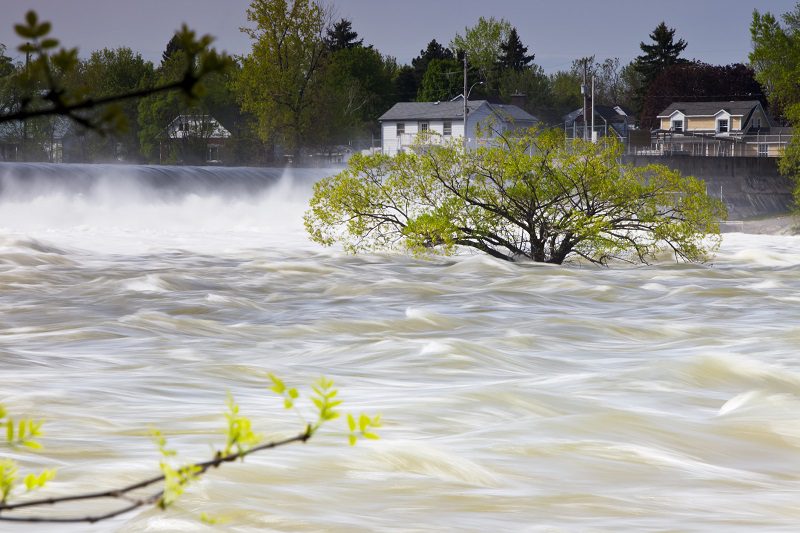Devil in the details: Canada’s proposed flood program

When Canadian homeowners finally get access to Canada’s proposed national flood insurance program, P&C insurance industry professionals are curious how it will will affect the country’s real estate and mortgage industries.
The question has already come up in the United States and the United Kingdom, where national flood insurance programs exist. Canada does not have a national flood program, although the federal government pledged to build one in its 2023 budget.
As part of the Canadian program, consumers will have online access to flood plain information that allows them to assess the risk of their home getting flooded. The federal government says the program should be announced publicly in Spring 2024, and Insurance Bureau of Canada (IBC) is calling for the government to launch the program in April 2025.
IBC notes 10% — or roughly 1.5 million — Canadian households are built in high-risk flood areas. And about 90% of insurers’ flood liability is associated with this 10% of households.
“Fully one-third of the financial liability [for flood] resides in the riskiest 1% of households,” IBC chief economist and vice president of policy development Jordan Brennan, said at a panel discussing flood insurance at the National Insurance Conference of Canada (NICC) in Montreal. “So that’s the situation we find ourselves in now. That’s the intolerable present.”
Canadian P&C insurers are currently working with the federal government on a private-public partnership model to make flood insurance available to people living in these high-risk areas. In this model, theoretically, the private insurance industry will pay out for a certain portion of flood catastrophes, and a federal government backstop will cover flood damage above and beyond that threshold.
One question open for discussion within Canada’s P&C industry is: What happens if the value of a policyholder’s home is reduced because it’s found to be in a high-risk area for flooding?
“If we say to a homeowner, you’re actually in a high risk flood zone, what does that do to the value of their home? If they’re going to have to resell it…there could be a small portion of our population, it could be one of us, who are sitting in a place where the value of our home is going to be not as good as it was before,” said NICC panellist Susan Penwarden, managing director of personal lines at Aviva Canada.
“And if I look at Flood Re [the national flood insurance program in the U.K.], one of the reasons they did Flood Re was not because flood [coverage] wasn’t available. It was because of the costs being so high. They really worried that if they suddenly moved to market cost for flood [insurance], the mortgage market would crash, and the housing market would crash. And if anybody who’s lived in the UK, as I have, knows, the housing market is big part of the economy over there.
“They were quite worried…it would be a precipitous drop. In talking to one of my colleagues who’s involved with it, he said, ‘Look, it was never about availability. It was about affordability, and then gradually moving that affordability to the right level.”
Part of the U.K. Flood Re model addresses the sensitive topic of ‘strategic retreat.’ In other words, re-locating people and developers out of flood-prone areas.
Matt Wolfe, president and CEO of Aon Reinsurance Solutions Canada, noted how the Flood Re model incorporates an element of strategic retreat into its model.
“If you had a flood [in a high-risk flood zone], they would not allow reconstruction,” Wolfe said. “In addition, if it was in a designated high-risk flood zone, they wouldn’t insure new construction. That’s a smart, gradual approach, where you’re saying, ‘Okay, post-event you’ll collect [flood insurance]. But we’re not going to rebuild there. Builders, developers, you’re not going to be able to rebuild there and offload this risk to Flood Re.
“I think there’s a great lesson for us as we move forward.”
One argument for creating a flood insurance program in Canada is that the lack of availability of flood insurance could actually make things worse for P&C insurers. In the U.S., noted NICC panellist Jolee Crosby, incoming president and CEO of Swiss Re Canada & English Caribbean, people are automatically given the basic flood coverage and must opt out of it. That way, they have to make a conscious decision not to be insured for flood.
“That’s a lesson we learned from the U.S., where it’s driven so much from the mortgage industry,” said Crosbee. “Those properties that don’t have flood insurance, they don’t have a mortgage on their property, so they choose not to get flood insurance. These are lower-income properties that have been generational homes. After [Hurricane] Fiona came in and decimated a whole area of Florida, there was no flood insurance. And so people lost their homes.
“And then what happened? You had opportunistic developers coming in and offering prices, offering to buy the property, and it creates this vicious circle. Because then people don’t have a place to go for new housing. You can you build more expensive properties in place of other properties, and then it just creates more of a difficult situation.
“So I like the thought of going in that direction [of people automatically getting opted into the national flood insurance program].”
Feature image courtesy of iStock.com/drewhadley



